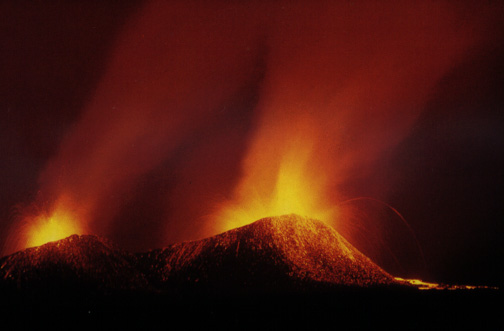|
Volcanism in the Galapagos Islands Galapagos Eruption's  | | An eruption on Cerro Azul. Picture source: http://www.geo.cornell.edu/geology/GalapagosWWW/CerroAzulEruption.jpg |
Historic eruptions have occurred on many of the Galapagos volcanoes, including Fernandina, Volcan Wolf, Alcedo, Sierra Negra, Cerro Azul, Santiago, Pinta, Floreana, and Marchena. Eruptions in the recent geologic past (the last ten thousand years or so) have also occurred on Volcan Darwin, Volcan Ecuador, Genovesa, San Cristobal, and Santa Cruz. A number of submarine volcanoes many have also been active in this time. It is quite unusual for a mantle plume to produce so many simultaneous active volcanoes. In Hawaii, for example, only 6 volcanoes (including the seamount Loihi) have erupted in this same time, and most of the activity in Hawaii is located on just 3 volcanoes). In Reunion, only a single volcano has been active. It should be noted, however, that the magma output of Mauna Loa, the largest of the Hawaiian volcanoes, has probably exceeded the output of all the Galapagos volcanoes combined.
The islands of Espanola and Santa Fe are remnants of extinct volcanoes. In both cases, only part of the volcanic structure has been preserved, the remaining parts having been faulted away. Espanola and Santa Fe have been extinct for several million years. Pinzon and Rabida are both small extinct shield volcanoes that have not been active for about 1 million years. Though Santa Cruz and San Cristobal remain active volcanoes, parts of their edifices are much older, more than a million years in the case of Santa Cruz (including its small neighbors of Baltra, Seymour and Las Plazas), and nearly two and a half million years in the case of San Cristobal.
|







